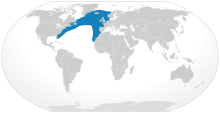| North Atlantic right whale[1] | |
|---|---|

| |

| |
| Size compared to an average human | |
| Scientific classification | |
| Domain: | Eukaryota |
| Kingdom: | Animalia |
| Phylum: | Chordata |
| Class: | Mammalia |
| Order: | Artiodactyla |
| Infraorder: | Cetacea |
| Family: | Balaenidae |
| Genus: | Eubalaena |
| Species: | E. glacialis
|
| Binomial name | |
| Eubalaena glacialis (Müller, 1776)
| |

| |
| Range map | |
| Synonyms[4][5] | |
| |
The North Atlantic right whale (Eubalaena glacialis) is a baleen whale, one of three right whale species belonging to the genus Eubalaena,[1] all of which were formerly classified as a single species. Because of their docile nature, their slow surface-skimming feeding behaviors, their tendencies to stay close to the coast, and their high blubber content (which makes them float when they are killed, and which produces high yields of whale oil), right whales were once a preferred target for whalers. At present, they are among the most endangered whales in the world,[6] and they are protected under the U.S. Endangered Species Act and Marine Mammal Protection Act and Canada's Species at Risk Act. There are an estimated 356[7] individuals in existence in the western North Atlantic Ocean—they migrate between feeding grounds in the Labrador Sea and their winter calving areas off Georgia and Florida, an ocean area with heavy shipping traffic. In the eastern North Atlantic, on the other hand—with a total population reaching into the low teens at most—scientists believe that they may already be functionally extinct.[6][dubious – discuss] Vessel strikes and entanglement in fixed fishing gear, which together account for nearly half of all North Atlantic right whale mortality since 1970,[8] are their two greatest threats to recovery.[9][10]
- ^ a b Mead, J. G.; Brownell, R. L. Jr. (2005). "Order Cetacea". In Wilson, D. E.; Reeder, D. M. (eds.). Mammal Species of the World: A Taxonomic and Geographic Reference (3rd ed.). Johns Hopkins University Press. pp. 723–743. ISBN 978-0-8018-8221-0. OCLC 62265494.
- ^ Cooke, J.G. (2020) [errata version of 2020 assessment]. "Eubalaena glacialis". IUCN Red List of Threatened Species. 2020: e.T41712A178589687. doi:10.2305/IUCN.UK.2020-2.RLTS.T41712A178589687.en. Retrieved 28 March 2021.
- ^ Cite error: The named reference
CITESwas invoked but never defined (see the help page). - ^ "ITIS Standard Report: Eubalaena glacialis (Müller, 1776)". ITIS on-line database. Integrated Taxonomic Information System. Retrieved 6 September 2012.
- ^ Perrin, W.F. (2012). "Eubalaena glacialis Müller, 1776". World Cetacea Database. Retrieved 29 September 2012.
- ^ a b Cite error: The named reference
noaa5yearwas invoked but never defined (see the help page). - ^ "Population size estimation of North Atlantic right whales from 1990-2022" (PDF). 23 October 2023. Retrieved 3 March 2024.
- ^ Cite error: The named reference
CA-SAR-2007was invoked but never defined (see the help page). - ^ National Oceanic and Atmospheric Administration (2011-01-23). "Scientists Successfully Use Sedation to Help Disentangle North Atlantic Right Whale". ScienceDaily. Retrieved 2011-01-27.
- ^ Taylor, S.; Walker, T. R. (2017). "North Atlantic right whales in danger". Science. 358 (6364): 730–731. Bibcode:2017Sci...358..730T. doi:10.1126/science.aar2402. PMID 29123056. S2CID 38041766.
